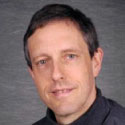Introduction to the Prawler Mooring

Professor
University of North Carolina
University of North Carolina
Dr. Bingham received his Ph.D. from the University of California, San Diego in Oceanography. His research interests include global distributions of sea surface salinity and large scale regional physical oceanography in the Kuroshio, the western North and Equatorial Pacific, and Onslow Bay, North Carolina.
Webinar Clip
The Prawler mooring was developed by the Pacific Marine Environmental Laboratory located in Seattle, Washington. What makes this type of mooring innovative is its use of a Prawler device: a profiling "crawler" which essentially works its way up and down the mooring line by using wave action as its power source and collects a variety of measurements. In this clip, Dr. Bingham also explains that sometimes, science experiments experience hiccups, using one particular mooring as an example. Full webinar: Follow that Salt! Results and the Future of Salinity Exploration
Click here for a transcript of this clip (PDF, 35.4 KB). |
Resources
Applicable Science Standards
 Asking Questions and Defining Problems. A practice of science is to ask and refine questions that lead to descriptions and explanations of how the natural and designed world(s) works and which can be empirically tested.
Asking Questions and Defining Problems. A practice of science is to ask and refine questions that lead to descriptions and explanations of how the natural and designed world(s) works and which can be empirically tested. Using Mathematics and Computational Thinking. In both science and engineering, mathematics and computation are fundamental tools for representing physical variables and their relationships. They are used for a range of tasks such as constructing simulations; solving equations exactly or approximately; and recognizing, expressing, and applying quantitative relationships.
Using Mathematics and Computational Thinking. In both science and engineering, mathematics and computation are fundamental tools for representing physical variables and their relationships. They are used for a range of tasks such as constructing simulations; solving equations exactly or approximately; and recognizing, expressing, and applying quantitative relationships. Constructing Explanations and Designing Solutions. The goal of science is the construction of theories that provide explanatory accounts of the world. A theory becomes accepted when it has multiple lines of empirical evidence and greater explanatory power of phenomena than previous theories.
Constructing Explanations and Designing Solutions. The goal of science is the construction of theories that provide explanatory accounts of the world. A theory becomes accepted when it has multiple lines of empirical evidence and greater explanatory power of phenomena than previous theories.